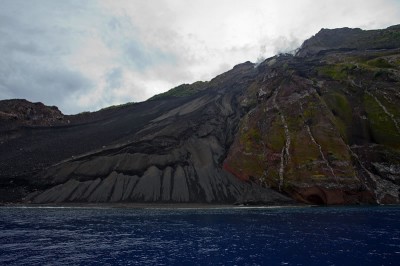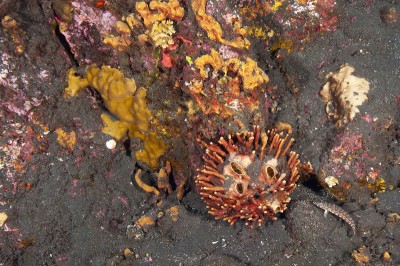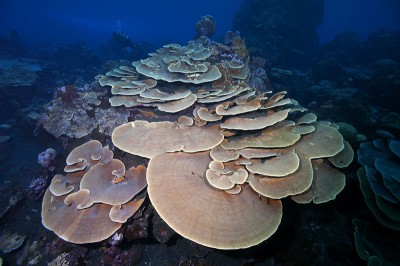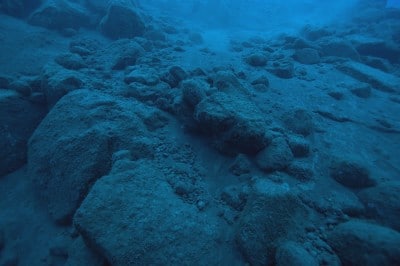After our dive earlier in the mission where we could hear the submarine explosions of Kavachi, the underwater volcano (and occasionally nascent island landmass), we were told that we were in for a special treat on the last day of the mission—we’d be scuba diving an active volcano! While we were doing our surveys of the Reef Islands in Temotu, the easternmost province of the Solomon Islands, we could see the conical silhouette of Tinakula off in the distance to the west. We left the Reef Islands after several days of surveying there and early in the morning headed west. By breakfast Tinakula loomed large on the horizon. As word spread that we were arriving at our destination, scientists and crew grabbed cameras from their cabins and joined each other on deck to marvel at the beauty of this spectacle. We all tried our best to somehow capture it photographically so we could later relate to our friends and family how it felt to see this volcano up close, though words and pictures will never fully convey the feeling of being there in person.
Tinakula is an unpopulated island though there was once a small settlement which left in the wake of a major eruption and related tsunami in 1971. The conical stratovolcano last erupted in 2012; but sulfury fumaroles at its summit of 851 meters still continue to spew clouds of smelly steam showing that the hotspot powering it is still restless and the volcano is far from dormant.

Panoramic image of Tinakula showing its varied landscapes from fresh black ash fields on the left, bare rock slopes in the center, and lush verdant growth on the right.


Detail of the steamy summit with fumeroles hinting at forces active below the surface. The steep loose ash/cinder slope from the most recent eruption terminates in a narrow black sand beach.
We loaded our gear and boarded our dive boat Calcutta to head out for our morning dives. Our first dive was in a location away from the most recent eruption. Beneath the surface we were greeted to an alien landscape very different from our normal coral reef dives. As I tried to take overview photos of the dive site I found I had to adjust my camera’s settings significantly to account for the black environment and the overcast skies which made my first attempted photos look like I’d left the lens cap on. I started my coral photo transect work down at 20 meters on the steep slope which was composed of rocky outcrops interspersed with chutes of loose volcanic gravel and sand which would slide toward the deep with little provocation. The areas of solid substrate were covered with more live coral than I was expecting. I also noticed a fine assortment of sponges encrusting the boulders and ridges as well as many unusually shaped sponges that I’d never seen before. As I worked my way shallower I encountered areas thickly shingled with healthy scrolls of Montipora and Turbinaria corals.



Deeper down the steep slopes, coral is present but sparse on rocky outcrops between large expanses of fine black sand. In some areas the boulders are dominated by a great variety of encrusting and oddly shaped sponges. The shallows under the verdant jungle side of the island are likewise lush with healthy stands of coral.
(Click-thru on images for greater detail.)
After our two morning dives, we return to the Golden Shadow for lunch and to our refill tanks for an afternoon dive—the final one of the mission. When we went back out we started our dive in the area where the most recent eruption entered the water. As expected, this area differed significantly from our morning dives—the terrain was barren, almost lunar looking in its uniformity. Very few coral recruits had been able to colonize this shifting landscape. It’s likely that heavy rains would cause the very steep ash and cinder slopes above the surface to send down clouds of fine material, blanketing the bottom and making for hostile conditions in which to get a reef restarted. Over time, and in the absence of further eruptions in this area, corals will once more gain a foothold and this section will begin to resemble the habitat of our morning dives.


The landscape below the area of the most recent eruption is quite barren. Corals have not yet begun to colonize the boulders and there is very little life evident in this otherworldly scene of monotone black.
Scuba diving an active volcano like Tinakula was a memorable way to end our eventful survey mission in the Solomon Islands. In case you missed it, you can read about our earlier dive near Kavachi here:
https://livingoceansfoundation.org/kavachi-submarine-volcano/
Photos by Ken Marks.